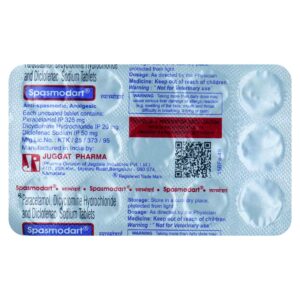DICYCLOMINE + PARACETAMOL + DICLOFENAC
Dicyclomine: Dicyclomine is an anticholinergic drug that is primarily used to treat symptoms associated with irritable bowel syndrome (IBS), such as abdominal pain and cramps. It belongs to a class of medications known as antispasmodics, which work by relaxing smooth muscles in the gastrointestinal tract.
The exact mechanism of action of dicyclomine is not fully understood, but it is believed to inhibit the muscarinic receptor (specifically, the M1 and M2 subtypes) in the smooth muscles of the gastrointestinal tract. By blocking the action of acetylcholine, a neurotransmitter that stimulates muscle contractions, dicyclomine helps to reduce the spasms and cramps that are associated with IBS.
Dicyclomine is usually taken orally in the form of tablets or capsules. The recommended dose for adults with IBS is typically 20 mg taken 4 times a day, before meals and at bedtime. However, the specific dosing may vary depending on individual response to the medication. It is important to follow the instructions provided by the healthcare professional or as stated on the prescription label.
Common side effects of dicyclomine include dry mouth, blurred vision, drowsiness, dizziness, constipation, and difficulty urinating. It may also cause headache, nausea, vomiting, sweating, and a decreased ability to sweat. In rare cases, serious side effects such as an allergic reaction, rapid heartbeat, or difficulty breathing may occur. If any severe or persistent side effects are experienced, it is important to seek immediate medical attention.
Dicyclomine may not be suitable for everyone, especially those with certain medical conditions such as glaucoma, urinary retention, gastrointestinal obstruction, or myasthenia gravis. It may also interact with other medications, including certain antidepressants and antihistamines. Therefore, it is important to inform the healthcare professional about any existing medical conditions, allergies, or other medications being taken before starting dicyclomine.
As with any medication, it is recommended to consult with a healthcare professional for proper diagnosis, dosing, and guidance on side effects management.
Paracetamol: Paracetamol, also known as acetaminophen, is a common over-the-counter medication used to relieve mild to moderate pain and reduce fever. It belongs to the class of drugs called analgesics and antipyretics.
Paracetamol works by inhibiting the production of certain chemicals in the body, called prostaglandins, which are responsible for causing pain and fever. By reducing the production of these chemicals, it helps to alleviate pain and reduce fever symptoms.
The recommended dose of paracetamol for adults is usually 500-1000mg every 4-6 hours, not exceeding 4000mg (4g) in a 24-hour period. For children, the dose is based on their weight and is typically lower than adult doses. It can be taken with or without food, but it is important to follow the instructions on the packaging or as directed by a healthcare professional.
While paracetamol is generally considered safe when taken at recommended doses, it is not without side effects. Common side effects may include nausea, vomiting, abdominal pain, and liver toxicity, especially when taken in excessive doses or for prolonged periods. It is important to adhere to the recommended dosage and seek medical advice if symptoms persist or worsen.
Individuals with certain medical conditions, such as liver disease or a history of alcohol abuse, should consult a healthcare professional before taking paracetamol as it can interact with certain medications and pose a risk to the liver.
Overall, paracetamol is a widely used and effective medication for relieving pain and reducing fever when used appropriately. However, it is important to read and follow the instructions on the packaging or consult a healthcare professional for proper dosing and to avoid any potential side effects or drug interactions.
Diclofenac: Diclofenac is a nonsteroidal anti-inflammatory drug (NSAID) that is commonly used to treat pain, inflammation, and swelling. It belongs to the propionic acid class of NSAIDs and is available in various forms such as tablets, capsules, gels, patches, and injections.
The drug works by inhibiting the production of prostaglandins, which are substances responsible for inflammation, pain, and fever. Diclofenac specifically targets the enzyme cyclooxygenase (COX), which is involved in the production of prostaglandins.
Diclofenac is commonly prescribed for conditions such as osteoarthritis, rheumatoid arthritis, ankylosing spondylitis, and menstrual pain. It can also be used to relieve acute pain from injuries or post-surgical procedures.
The dose of diclofenac can vary depending on the form and strength of the medication. It is usually taken orally, with or without food, and the usual dose ranges from 25 to 50 mg, taken 2 or 3 times a day. The dosage may be adjusted based on individual response and the severity of the condition.
Like other NSAIDs, diclofenac may cause certain side effects. Common side effects include stomach upset, heartburn, nausea, diarrhea, or constipation. In rare cases, it may cause more serious side effects such as stomach ulcers, bleeding, liver problems, kidney problems, and allergic reactions. Long-term use of diclofenac or use at high doses may increase the risk of these side effects.
It is important to take diclofenac as prescribed by a healthcare professional and to report any unusual or severe side effects. The drug should be used with caution in individuals with a history of stomach ulcers, heart disease, high blood pressure, kidney problems, liver problems, or asthma.
Diclofenac should not be used in the third trimester of pregnancy as it may harm the unborn baby. It may also pass into breast milk, so nursing mothers should consult their doctors before using this medication.
As with any medication, it is essential to discuss the risks and benefits of diclofenac with a healthcare professional before starting treatment.

